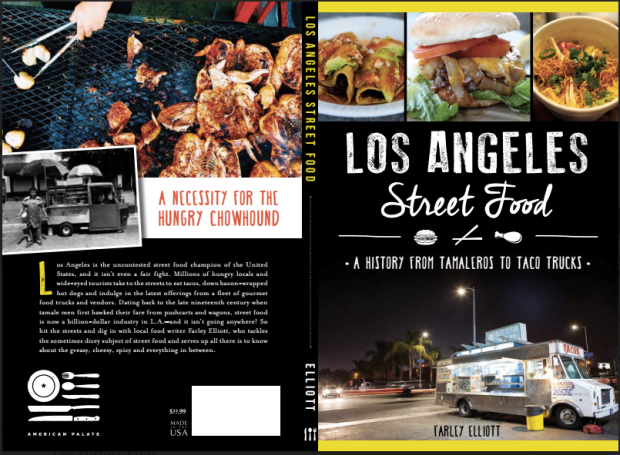 One thing that has always impressed me about Farley Elliott is his dedication to thorough research. The first food article of his that I read was a search for the best burgers in LA back in 2010. And you can bet he ate every burger he could find from Pasadena to Long Beach and all points West. He also has the ability to synthesize new information with his extensive knowledge base and explain it clearly to the reader. His new book, LA Street Food: A History from Tamaleros to Taco Trucks is a fun and educational read, a well-researched history, and a guide to some of the best street food in LA. You can purchase the 168-page softcover at Amazon.com.
One thing that has always impressed me about Farley Elliott is his dedication to thorough research. The first food article of his that I read was a search for the best burgers in LA back in 2010. And you can bet he ate every burger he could find from Pasadena to Long Beach and all points West. He also has the ability to synthesize new information with his extensive knowledge base and explain it clearly to the reader. His new book, LA Street Food: A History from Tamaleros to Taco Trucks is a fun and educational read, a well-researched history, and a guide to some of the best street food in LA. You can purchase the 168-page softcover at Amazon.com.
Farley was kind enough to field some questions about “LA Street Food” from The LA Beat. His answers are indepth and thoughtful, of course, we would expect nothing less from him. A listing of upcoming book signings follows the interview.
The topic seems like it would be difficult to research. I see you cite only three sources. Was most of your research accomplished through interviews? Who were your best sources of information?
For the history portion of the book, there’s obviously so much more to talk about than any three people or books could possibly have. To really get into the background of a cuisine, or the fluctuation of a population from more than 150 years ago, takes an immense amount of research and time. Ultimately, “LA Street Food” is meant to offer readers a look at the deeper background behind many of the foods they may have taken for granted, without falling into becoming a 1,000 page textbook on the subject.
As for researching the places to go and the things to eat — well, that was just plain ol’ boots-on-the-ground reporting!
I have always been impressed by your intensive boots-on-the-ground reporting…How would you differentiate LA street food from New York street food?
Well there’s the reliance on different types of cuisine, for one. But mostly it’s about regulation and acceptance. You have carts like the Halal guys in Midtown who are celebrated internationally, and are able to thrive where they are because the city allows them to. In Los Angeles, even our best trucks and stands are mostly a local phenomenon only, because they aren’t supported from the top down the way New York City’s vendors are.
You discuss tamale carts and Chinese street vendors, but do you think the chuck wagon had any place in the first mobile food service?
Chuck wagons have their own incredible story to tell, and it really comes on the back of Western migration and expansion. There’s obviously a timeline overlap with the growth of Los Angeles as a city and the arrival and popularity of chuck wagons throughout the West, but this book is more focused on L.A. proper, and the rise of street food within its borders. The simple fact is, though: street food, at some level, predates many of the very streets our city was built on, and will always have a home in our nation’s culinary landscape.
Do you consider Grand Central Market to be street food? How do you feel about the recent gentrification of the market? Would you consider gentrification the right word? Or revitalization?
I had a lot of discussions with a lot of people about what this book would really look like — should I cover only places that vend on sidewalks or in parking lots or on the street? What about international street food options that are being made by brick-and-mortar restaurants? In the end, I went on feeling. Grand Central Market to me has a feeling of street food, even though it’s a dedicated address with some limited seating. But for anyone looking to expand their knowledge of food and try something out of their comfort zone, Grand Central Market is an invaluable resource. For those reasons alone, plus GCM’s own interesting history within the street food narrative overall, it had to be included.
As for its recent renaissance, I wouldn’t call it a gentrification, per se. I think the market has done a decent job of supporting all vendors, whether they’ve been there 35 years or two. I think the lines still appear at places like Las Morelianas and Sarita’s for a reason (because they’re delicious), even as more foot traffic siphons off towards Eggslut or G & B Coffee. At the end of the day, the market, which is approaching its 100th birthday, has always been about flux, from early white produce vendors to Chinese medicine stalls and mid-century butchers, on up through the tacos and tortas spots of the last 20 years and today’s enviable blend of Thai, Jewish, American, Southern, and Mexican flavors.
Do you think there is a danger in shining a light on vendedores? Have you taken any precautions to protect them?
None of the vendors I’m writing about are so unknown that I’m ‘outing’ them in any way. Places like the Mercado Olympic, which is discussed in my book, are thriving culinary enclaves already, and have endless blog posts and bigger feature stories under their belt. My book “LA Street Food” is meant to give outsiders or locally curious diners the tools they need to go exploring for these places that, in many circles, are already well-established.
In the end, I choose to write about street food vendors because, in many ways, they’re the most interesting (and most important) part of LA’s booming culinary tradition. Frankly, to not talk about street food, and the regulations and politics that comes with it, is to do a disservice to the many thousands of vendedores who keep this city fed. We should be doing more to give them their due.
Very true…I have often heard that food trucks are a fad that is going to be “over” but I think they have become an integral part of our street food landscape. What do you see as the future of food trucks?
Food trucks are not going anywhere. They’ll cluster together or start working more private parties or find a singular location from which to park nightly and ply their trade, but this is no fad. What I think you will see more of as time goes on, is smarter business people figuring out ways to use trucks as one part of their arsenal, rather than having inexperienced operators dive in head-first, trying to figure out how to tread water when they’re already in over their heads.
This is maybe a silly example, but look at the way the Kogi trucks or the In-N-Out Burger trucks act as an extension of a whole operation. Eating at Kogi is a vehicle with which to experience Roy Choi’s cooking, and that goes hand in hand with all of his other physical restaurant projects. The In-N-Out truck isn’t going to stop selling burgers because it’s not part of their existing store model; each can live a mutually beneficial existence.
Thank you so much for your time and for your thoughtful answers. We look forward to getting our personal copy signed at one of your appearances before we “tear pages out and hand them to [our] friends.”
Come see Farley:
Saturday, July 25 (5 p.m.): Reading excerpts at Skylight Books in Los Feliz
Sunday, August 9 (12 p.m.): BOOK LAUNCH at LA County Store! Party in Silver Lake!
Saturday, August 15 (1 p.m.): Reading from the book at the LA Public Library as part of their Culinary Historians panel
Keep up to date with additional appearances (and quality food writing) at his website.



